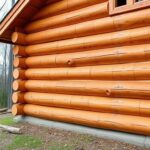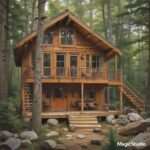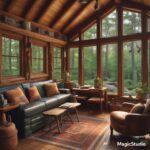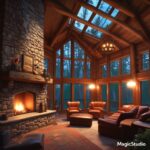For both people and their cats, living in a cabin during the summer months could be quite rewarding. Cat owners, though, should closely weigh the special conditions of the setting against their own needs. During the warmer months, when they are in a cabin setting, let’s look at all the aspects of keeping cats both safe and happy.
Grasping Your Surroundings in the Cabin
From conventional urban or suburban homes, a cabin setting varies greatly. Living in a cabin is typically rural, so it implies different structural considerations, proximity to animals, and changing temperatures. Your cat’s comfort and safety are directly affected by these circumstances.
Most cabins are built from wood and could have more gaps, splits, or openings than standard houses. Though this design gives a nice feel, it would certainly need extra care to protect your cat. Although they could also function as probable exit points or entry spots for unwelcome guests, natural ventilation through these openings can provide some relief on stifling summer days.
Cabin temperature control operations
In cabin conditions, summer temperatures can present major problems. Unlike many cabins, which use natural ventilation or mobile cooling solutions, contemporary houses have central air conditioning. Keepingp your feline friend at a safe temperature till call for careful planning.
With a natural core temperature of 101.0 to 102.25°F (38.3 to 39.2°C), cats, in general, handle heat better than people. Still, continuous exposure to extreme temperatures might cause heat stroke or heat stress. Thermometers placed in several cabin regions assist in tracking temperature changes all day.
Think about setting up cooling stations near your cabin. Position fans deliberately to promote air circulation but give your cat the ability to get away from front airflow if it wants. Properly hydrating, which becomes critical in hotter weather, is encouraged by deep bowl water stations all around the cabin.
Wildlife interaction and safety measures
The closeness to nature in cabin surroundings implies more opportunities for interaction with wildlife. Although cats are natural predators, they can, at the same time,e fall food to bigger creatures. Given this fact, outdoor access and security precautions need to be taken seriously.
Building a secure outdoor enclosure or “catio” offers a safe middle between total indoor containment and free outside access. This design should feature strong mesh or screening material blocking entry by local animals and their escape. Inspection of the enclosure is done routinely to guarantee its sustained integrity.
If you decide to keep your cat totally inside the cabin, indoor enrichment becomes especially vital. By keeping a distance from possible dangers, window perches let people observe outdoor events securely. Climbing structures and interactive toys assist in quenching natural hunting and exploration instincts.
Medical and health concerns
Living in a cabin setting calls for increased knowledge of your cat’s nutritional demands. The somewhat remote nature of several cabin sites could mean that immediate veterinary attention is hard to get. Keeping first aid supplies in good supply becomes very important.
In cabin environments, parasite prevention becomes particularly imperative. Other insects, ticks, and fleas commonly do well in the forests surrounding houses. Discuss with your vet suitable preventive medicines for your surroundings and location.
Particularly rabies, as exposure risks might rise in rural cabin surroundings, preserve current records of your cat’s shots. Should your cat accidentally getaway, having vital identification would be possible with busingmicrochipping; therefore, now might be a good time to do so.
Sensible Adjustments for Cabin Living.
To make your cabin cat-friendly, you need to make considered changes. Install secure window screens to keep kids in, let fresh air in, and view nature while also minimizing falls. Make sure all window screens are strong enough to support your cat’s weight.
In cabin environments, storage issues start to become very important. Many cabin owners keep supplies for long periods, including possibly dangerous chemicals such as antifreeze or cleansers. Establish secure, identified storage spots cats cannot reach.
Establish a regular feeding spot far from doors to reduce the chances of food serving. Furthermore, this maintains sanitation habits and lowers the risk of drawing wildlife.
Can Cats Live Safely in a Cabin for the Summer? Comprehensive Guide to Feline Cabin Living
For both people and their feline friends, living in a cabin in summer can be a learning experience. Still, this one-of-a-kind setting offers particular problems and issues cat owners have to cautiously assess. During the hotter months, we should investigate the full scope of keeping cats secure and cozy in a cabin.
Knowledge of Your Cabin Surroundings
From typical suburban or city homes, a cabin setting varies greatly. Living in a cabin usually means close contact with animals, different temperature levels, and special building issues. Your cat&’s security and comfort are affected directly by these considerations.
Most cabins are made of wood and could have more gaps, cracks, or openings than standard houses. Though this architectural style produces a lovely feel, it calls for particular care to guarantee your cat’s safety. While the natural ventilation via these holes may be of benefit on swelter summer days, they could also provide a route of escape for intruders or entry points.
Temperature Control in Cabin Settings
In cabin habitats, summer heat can present major issues. Unlike modern houses that have central air conditioning, lots of cabins depend on natural ventilation or small cooling systems. Maintaining safe temperatures for your feline friend will need careful planning in this instance.
With a normal body temperature between 101.0 and 102.5°F (38.3 to 39.2°C), cats usually bear heat better than people. Still, repeated exposure to high temperatures can cause heat stress or heat stroke. Thermometers put in various cabin areas allow for monitoring of temperature changes over time.
Think about setting up cooling facilities inside your cabin. Strategically place fans to help air circulate, but be sure your cat may escape from direct airflow if need be. Proper hydration is essential in hot weather, and the numerous deep bowl water points around the cabin help with this.
Wildlife interactions and safety precautions
In cabin surroundings, the closeness to nature implies more wildlife encounters. Although cats are natural predators, they can also be prey for more massive animals. This truth calls for thoughtful evaluation of outside access and safety provisions.
A secure outdoor enclosure or “catio” gives a safe compromise between full indoor confinement and allowed outdoor access. This design has strong mesh or screen fabric that blocks local animal movement out or in. Frequent examination of the enclosure helps it to persist intact.
If you decide to keep your cat only within the cabin, indoor stimulation becomes especially necessary. Window perches enable one to observe outside activities safely, even while keeping a distance from potential hazards. Climbing equipment and interactive playthings aid in meeting natural exploratory and hunting impulses.
Medical and Health Issues
A cabin setting calls for extra knowledge of your cat’s health demands. Since many cabin locations are relatively remote, fast veterinary help could not be easily found. It is crucial to keep a first aid kit well-equipped.
In cabin environments, parasite control becomes more crucial. Wooded areas around cabins are often the perfect habitat for fleas, ticks, and other pests. Speak with your vet regarding proper preventive medications ideal for your exact surroundings and location.
Particularly in rural cabin settings, since exposure risks can rise, keep up-to-date notes of your cat&’s immunizations, especially rabies. Microchips, if not already, offer vital identification in case your cat inadvertently gets loose; therefore, think of using them.
Real-world Adjustments for Living in Cabins
Creating a cat-friendly cabin calls for careful changes. By letting nature views in and increasing airflow, secure window screens keep one from falling. Make sure all window screens can support your cat’s weight in case it decides to lean on them.
In cabin circumstances, storage ideas become particularly pertinent. Tools for long periods are found by numerous cabin owners—including chemicals like cleaning supplies or antifreeze. Designate locked storage spaces unapproachable to inquisitive cats.
Reduce the chances of a runaway during meal preparation and serving by setting a regular feeding spot off of doors. Furthermore, this will assist in keeping order and lowering the chances of attracting wildlife.










